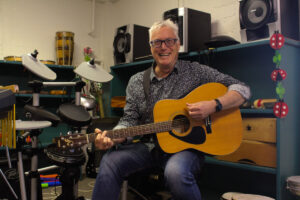Who cares if it is wet?
The prediction is for a wet Fieldays – but that won’t stop the punters, writes guest columnist Kingsley Field
If it’s June and it’s raining it’s because the Fieldays are on.
It’s a hoary old adage, for sure, but it has been unpleasantly true more often than not over the past 46 years, and maybe this year will add to the collection of Fieldays gumboot-weather events staged in the Waikato since 1968. By and large, the majority of those who attend the hugely-popular annual National Fieldays four-day show dress accordingly and pay the weather not a fig’s worth of notice. Conversely, the few who don’t dress properly, but who instead glad-rag themselves in gaudy threads and fancy footwear, soon discover the error of their ways and either immediately splurge on Swannies and gummies or head home early muttering dark imprecations about “who’d want to be a cockie anyway?”
Well, the answer rather emphatically is that tens of thousands of folk want to be cockies in one form or another, as is shown every year by land-people who flood the Mystery Creek site in ever-increasing numbers. They come from all over the country, and an additional several thousand arrive as international visitors. As well, tens of thousands more, from rural villages, country towns and the nation’s biggest cities pour into the site. And virtually all of them are fascinated, intrigued, astounded, amazed or bemused at the enormity of the site’s tent city and the extraordinary range of “stuff” there is on display.
But to get it there and to have it all clean and tidy and properly shown off has taken thousands of hours of work over the past half year and more. For months National Fieldays’ staff and contractors have been improving and adding to the site’s grounds and amenities. The place has had a $1.6 million facelift, with 26 additional exhibition sites added. This takes exhibitor numbers to more than 1000 and exhibitor sites to more than 1400, making the show easily the biggest agribusiness exhibition in the Southern Hemisphere. In fact, it’s been that way for years, and it just keeps getting bigger.
A visit to the site in the middle of last week showed a real intensity of activity as exhibitor staff and contractors pushed hard to get their individual displays up and running.
Many of the plots already had their tents erected, and hundreds of tonnes of wood chips, saw-dust, bark, sand and even big slabs of rock were being shuffled around by hand or powerful little front-end loaders to create attractive display areas and comfortable, mud-free places for the hoped-for buyers to discuss business. Potted native trees, ferns, tussocks, grasses, flaxes and other herbage were all being carefully and strategically placed to look natural and inviting. By contrast there were huge tractors with enormous wheels, the machines gleaming in fresh red or orange or yellow or green paint and their tyres all newly painted in shiny tyre-black.
Logs and posts and rails and boards were being firmly planted in the ground or nailed or screwed to supports; mounds of earth or stone had been formed so craftily-angled 4×4 trucks and utes and vans could be shown off to advantage; immense cropping machines languished haughtily on beds of bark; and away down the other end of the 113ha site (car-parks included) the Lifestyle Marquee was humming with exhibitors setting up to spruik the latest in frying pans, potato peelers, wine, sheep’s milk cheese, and woolly socks.
The fact that it was raining was of no consequence. There was a little mud here and there, but the hardy workers slogged on with the job, regardless of sodden clothing and footwear.
It was all aimed for kick-off at 8am today, when the first tsunami of an estimated 120,000 visitors will pour down the hill. And, as has happened every year for almost half a century in the Waikato, the National Fieldays are here again, they’re ready, and they will be good.
Who cares if it’s wet?




